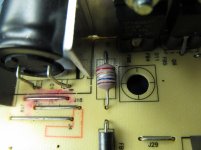This looks like a coil to me,
What is the marking on the pcb ?
Just now i see....R1
0.16R?(current sensor)
is this connected to emitter of power transistor?
What is the marking on the pcb ?
Just now i see....R1
0.16R?(current sensor)
is this connected to emitter of power transistor?
Last edited:
I can't see any fuse..Yes it is. Has a fuse in series with it which obviously didn't do it's job.
Is this resistor open?
If you say about FB this is a ferrite bead.
Last edited:
Some resistors also mark the temp. coefficient. So I would read br 1, bl 6, silv-x0,01, gold tol. +/-5% , red temp. coeff. +/- 50 ppm/°K. It makes sense, but I´m not sure.
"If you say about FB this is a ferrite bead" yes this was what I was referring to. It measured very low so I assumed circuit protect fuse.
Went to a TV shop & owner matched colors to one on a TV board with only exception being last color band which probably temp like you said. It was .16 ohms. Thanks for all replys.
As has been said, bands are
1-brown=digit is 1
2-blue=digit is 6
3-silver=multiplier is 0.01
4-gold=tolerance is 5%
5-red= temp coefficient is 50 ppm/ºC
And it looks like a fusible resistor to me, with the chalky grey coating.
1-brown=digit is 1
2-blue=digit is 6
3-silver=multiplier is 0.01
4-gold=tolerance is 5%
5-red= temp coefficient is 50 ppm/ºC
And it looks like a fusible resistor to me, with the chalky grey coating.
All mouser had was .15ohms. Would that be close enough?
That depends what it's purpose was.
If the resistor is supposed to be a current shunt then you need the .16 ohm.
If the resistor is there to for another purpose like help lowering surge current slightly, then you could change it's value slightly.
I think you should try to trace out the circuit enough to get an idea what it is there for.
We should have a look at the tolerances. The original resistor says 5%, so the value can range from 0,152 (-5%) to 0,168 (+5%). If the tolerance of the 0,15 ohm resistor is 1% (it´s not unlikely, look at the datasheet of the new res.), the value ranges from 0,1485 to 0,1515, imo very close to the lower end of the original.
If more precision is needed, there is still the option of paralleling 2 resistors.
If more precision is needed, there is still the option of paralleling 2 resistors.
Hello, Late to the party as usual, but I am repairing the same power supply, and as R1 described before is open circuit, I cannot verify the resistance.
Several sites insist that the resistor has a white or grey band in the center if it is a 5-band resistor, but the paint described here is what I see as well as silver.
Can anyone verify that this is indeed a .16 ohm 5% 50PPM resistor?
All I can find online that is even close is linked below, and it is a .16 Ohm Resistor of different composition, but has the 5% tolerance, but no Temp coefficient listing. It is described as for use in surge protection, which makes sense for Where the resistor is located, but I do not have a voltage reading into the resistor, so I'm not sure if the 2W range is reasonable for this application.
Does anyone have any ideas? Did paralleling 2 resistors work?
https://www.westfloridacomponents.com/WW556PD/2W+0.16+.16+ohm+Metal+Oxide+Resistor+RSF2WR16JT.html
Several sites insist that the resistor has a white or grey band in the center if it is a 5-band resistor, but the paint described here is what I see as well as silver.
Can anyone verify that this is indeed a .16 ohm 5% 50PPM resistor?
All I can find online that is even close is linked below, and it is a .16 Ohm Resistor of different composition, but has the 5% tolerance, but no Temp coefficient listing. It is described as for use in surge protection, which makes sense for Where the resistor is located, but I do not have a voltage reading into the resistor, so I'm not sure if the 2W range is reasonable for this application.
Does anyone have any ideas? Did paralleling 2 resistors work?
https://www.westfloridacomponents.com/WW556PD/2W+0.16+.16+ohm+Metal+Oxide+Resistor+RSF2WR16JT.html
two 0r33 would give 0r165
If you really need 0r16 then add a 5r1 in parallel to give 0r15983 +-5%
Metal oxide will not give 50ppm/C, they usualy come in around 300ppm/C
You will need a metal film or metal wire to get 50ppm/C, but do check, many are 100ppm/C
That post 1 pic is clearly agreed to be silver (x0.01times). If your resistor is white then it is something completely different 169ohms? Never heard of that value. and it can't be x10^9 !!!
If you really need 0r16 then add a 5r1 in parallel to give 0r15983 +-5%
Metal oxide will not give 50ppm/C, they usualy come in around 300ppm/C
You will need a metal film or metal wire to get 50ppm/C, but do check, many are 100ppm/C
That post 1 pic is clearly agreed to be silver (x0.01times). If your resistor is white then it is something completely different 169ohms? Never heard of that value. and it can't be x10^9 !!!
- Status
- Not open for further replies.
- Home
- Amplifiers
- Power Supplies
- Help identifying resistor
